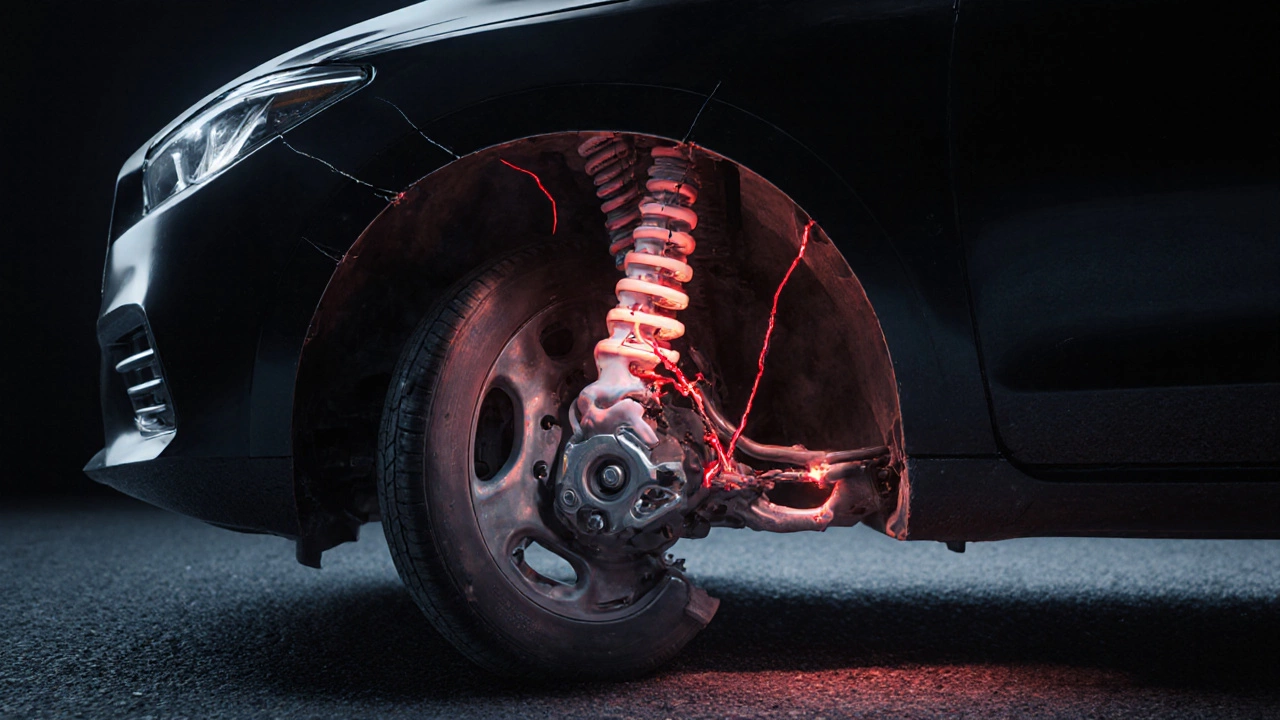Suspension Noise Diagnostic Tool
Identify what your car's suspension noise means and what repairs you may need. Select the sound you're hearing to learn what it indicates and what to do about it.
Likely Causes:
Recommended Actions:
Ever heard a weird clunk, thud, or squeak coming from under your car and wondered if it’s something serious? If you’re hearing strange noises when you drive over bumps, turn corners, or even just roll slowly down a driveway, your suspension might be failing. And yes - suspension parts make distinct sounds when they break, and learning to recognize them can save you money, time, and maybe even your safety.
Clunking When You Hit a Bump
The most common sound of a failing suspension is a loud, hollow clunk or thud when you go over a pothole, speed bump, or uneven pavement. This isn’t just road noise - it’s metal hitting metal because something’s loose or worn out.
More often than not, this comes from worn control arm bushings or ball joints. These parts are made of rubber and metal, and over time, the rubber cracks and the metal starts to rattle inside. When you hit a bump, the loose joint slams against its housing. You might hear it more clearly when driving slowly over rough surfaces - like parking lot bumps or gravel driveways.
Some people ignore it, thinking it’s just the car being old. But a clunking ball joint can fail suddenly. If it breaks while you’re turning, you could lose steering control. That’s not a risk worth taking.
Knocking or Popping During Turns
Do you hear a rhythmic knock-knock-knock or a sharp popping sound when you turn the wheel - especially at low speeds in parking lots? That’s usually a sign of a bad CV joint or worn sway bar links.
CV joints connect your axles to the wheels. When the rubber boot tears, grease leaks out and dirt gets in. The joint starts to grind and click. The noise gets louder as you turn sharper. It’s often mistaken for a bad wheel bearing, but the key difference: a CV joint noise changes with steering angle. A wheel bearing hums constantly, no matter which way you turn.
Sway bar links are another culprit. These small metal rods connect the sway bar to the suspension. When their rubber bushings wear out, they rattle and knock when the car leans in a turn. It’s not dangerous right away, but it makes your car feel loose and vague on corners - and it’ll wear out other parts faster.
Squeaking or Creaking Over Bumps
A high-pitched squeak or creak - especially when you go over a bump slowly - often points to dried-out or cracked rubber components. Think strut mounts, coil spring insulators, or even bushings in the shock absorbers.
These parts don’t fail suddenly like ball joints. Instead, they slowly lose their ability to absorb vibrations. The noise usually gets worse in cold weather because rubber stiffens up. You might notice it more in the morning after a frosty night.
Some drivers try to fix this by spraying WD-40 on the springs. That might silence it for a few days, but it’s a band-aid. The rubber is already broken. Eventually, the noise returns - and now your shocks are working harder, wearing out faster.
Grinding or Metallic Screeching
If you hear a sharp, metallic screech or grind - especially when driving over rough roads - you’ve got a serious problem. This isn’t normal wear. This is metal-on-metal contact.
It usually means your shock absorbers or struts have completely failed. The internal piston is no longer cushioning the spring. The spring is slamming against its metal housing. You might also hear this if a broken spring coil is rubbing against the fender or frame.
Grinding sounds are often accompanied by other symptoms: your car bounces like a pogo stick after a bump, the tires lose grip on uneven surfaces, or you feel every crack in the road through the steering wheel. This isn’t just uncomfortable - it’s dangerous. Your tires aren’t staying planted, which means less control in wet conditions or during emergency stops.

Why You Can’t Ignore These Sounds
People often delay fixing suspension issues because they think it’s just a noise. But suspension isn’t about comfort - it’s about control. Every time you brake, turn, or accelerate, your suspension works to keep the tires on the road. If it’s broken, your tires bounce. If your tires bounce, you lose traction.
Studies show that worn suspension parts can increase stopping distances by up to 20% on wet roads. That’s the difference between stopping in time and hitting a car ahead of you. And it’s not just braking - steering response gets sluggish, cornering feels unstable, and your tires wear unevenly, which means you’re replacing them every 20,000 miles instead of 50,000.
Plus, a failing suspension puts extra stress on other parts: your tires, brakes, steering system, and even the frame of the car. Fixing one broken ball joint now might save you $1,200 in tire and brake replacements later.
What Parts Usually Fail First?
Not all suspension parts fail at the same time. Some wear out faster depending on your driving habits and road conditions.
- Ball joints: Fail most often on older cars or those driven on rough roads. Usually show up around 80,000-100,000 miles.
- Control arm bushings: Common on front-wheel-drive cars. Rubber degrades faster in hot climates or with frequent stop-and-go driving.
- Strut mounts: Wear out quicker if you drive on unpaved roads or carry heavy loads regularly.
- Sway bar links: Often overlooked. They’re cheap to replace, but if ignored, they cause poor handling and accelerate wear on other parts.
- Shocks and struts: Typically last 50,000-100,000 miles, but can fail sooner if you drive on gravel roads or haul heavy cargo.
If your car is over 8 years old or has more than 70,000 miles, it’s worth having a mechanic check these parts - even if you don’t hear noise yet. A visual inspection takes 15 minutes and can catch problems before they turn into expensive repairs.
How to Test Your Suspension at Home
You don’t need a lift or fancy tools to check for problems. Here’s a quick DIY test:
- Push down hard on each corner of the car - front left, front right, back left, back right. Let go.
- Watch how the car bounces. If it bounces more than once or twice, your shocks or struts are worn.
- Look under the car for leaking fluid on the shocks (oily residue), cracked rubber, or rusted metal.
- Check the tires. If the tread is worn more on the inside or outside edges, that’s a sign of misalignment caused by bad suspension.
- Drive slowly over a speed bump. Listen for clunks or rattles. If you hear them, it’s not the road - it’s your suspension.
This doesn’t replace a professional inspection, but it tells you when it’s time to call a mechanic.

What Happens If You Don’t Fix It?
Ignoring suspension noise doesn’t make it go away. It makes it worse - and more expensive.
Here’s what happens if you wait:
- Your tires wear out in 30,000 miles instead of 60,000 - that’s $600+ in extra costs.
- Your brakes wear out faster because the car’s weight shifts unpredictably - adding $400-$800 in brake repairs.
- Your steering components get damaged from the extra stress - alignment issues, power steering pump failure, or even bent tie rods.
- Eventually, a ball joint or control arm breaks while you’re driving - and you lose control.
One driver in Ohio replaced his worn struts after hearing a constant clunk. He waited six months. When the ball joint finally broke on a highway ramp, he spun out and totaled his car. Insurance paid out, but he lost his daily driver for three months. The repair he avoided cost $300. The accident cost him $12,000.
When to Get It Fixed
Don’t wait until the noise gets unbearable. If you hear any of these sounds - clunking, knocking, squeaking, or grinding - schedule a suspension check within the next week. If you also notice:
- Car leaning to one side when parked
- Steering feels loose or pulls to one side
- Braking feels spongy or the front dips heavily
- Tires are wearing unevenly
Then it’s already urgent. Don’t drive it far. Get it towed.
Replacing suspension parts isn’t cheap - but it’s cheaper than a wreck. A full front-end rebuild (ball joints, control arms, struts) might cost $800-$1,500. That’s less than half the price of a new tire set, plus new brakes, plus alignment, plus potential medical bills if you crash.
Can a broken suspension make your car pull to one side?
Yes. If one side’s suspension is worn - like a bad ball joint or collapsed strut - that side sits lower. This throws off the alignment, making the car pull toward the weaker side. You might also notice uneven tire wear on that side.
Is it safe to drive with a noisy suspension?
It’s risky. A squeak or creak might be harmless, but clunking, knocking, or grinding means parts are failing. If a ball joint or control arm breaks while driving, you could lose steering control. Don’t risk it. Get it checked before it fails on the highway.
How long do suspension parts usually last?
Shocks and struts typically last 50,000 to 100,000 miles. Ball joints and bushings often last 80,000 to 120,000 miles. But if you drive on rough roads, carry heavy loads, or live in a cold climate with salted roads, they wear out faster - sometimes as early as 40,000 miles.
Can bad suspension cause poor fuel economy?
Indirectly, yes. If your suspension is worn, your tires don’t stay flat on the road. This increases rolling resistance. Your engine has to work harder to maintain speed, which lowers fuel efficiency by 5-10%. Uneven tire wear also makes it worse.
Should I replace suspension parts in pairs?
Always. If one shock absorber or ball joint is worn, the other side is close behind. Replacing only one side creates imbalance. Your car will handle poorly, your tires will wear unevenly, and you’ll end up replacing the other side soon anyway. It’s cheaper and safer to do both at once.
Next Steps
If you hear a strange noise from your suspension, don’t guess. Don’t ignore it. Don’t wait until it gets worse.
Take five minutes right now: drive slowly over a speed bump and listen. Push down on each corner of your car and watch how it bounces. Look under the car for leaks or cracked rubber.
If you’re not sure, take it to a trusted mechanic. Ask them to check the ball joints, control arm bushings, and strut mounts. A basic inspection usually costs $50-$100 - and it could save you thousands.
Your suspension isn’t just there to make the ride smooth. It’s what keeps your tires on the road - and you alive.

